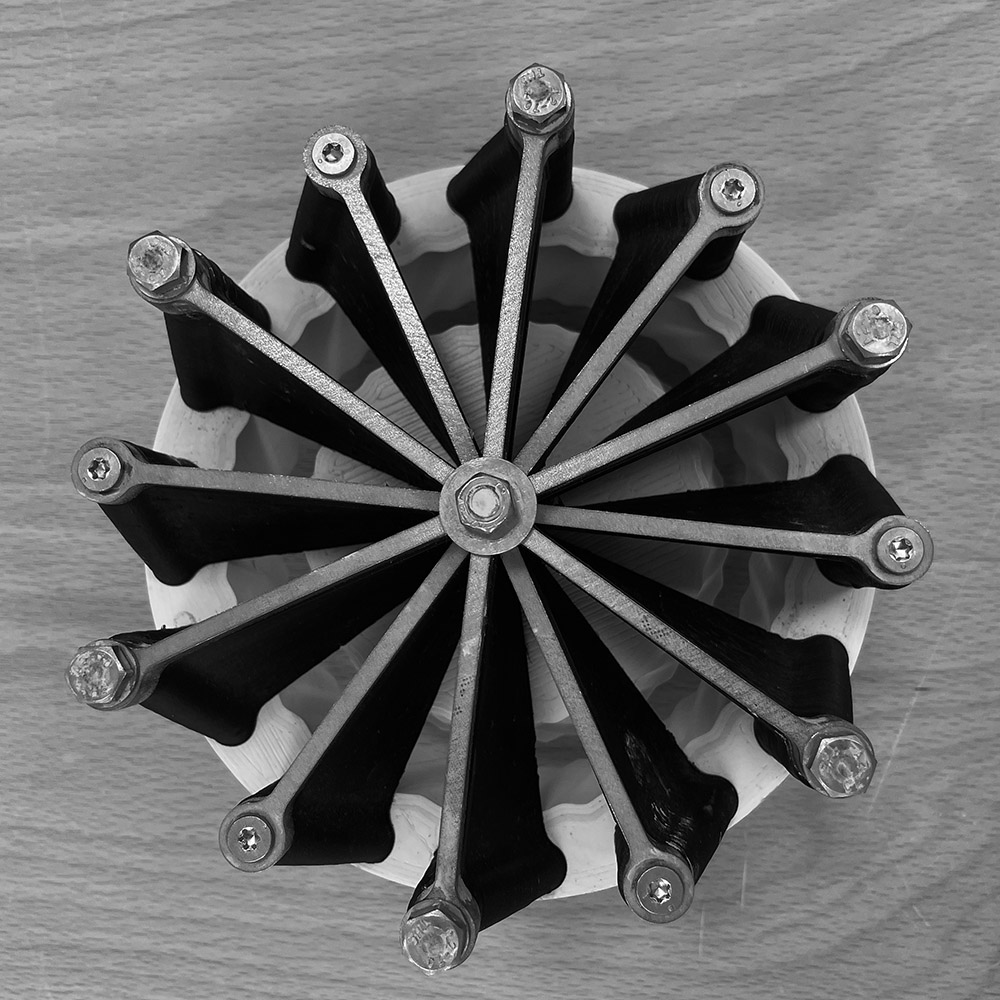Twisting Clay
Creative Research to Explore the Complex Rheology in Ceramic Extrusion
DOI:
https://doi.org/10.7577/formakademisk.5423Emneord (Nøkkelord):
Toolmaking, Ceramic Extrusion, Rheology, 3D Printing, ClaySammendrag
This paper details practice-based research exploring new creative possibilities involving the ceramic extrusion process. The paper begins by providing a short overview of the extrusion technique, its characteristics and some contextual coverage of the process. The paper then describes how both tacit knowledge and theoretical material understanding have been used to overcome technical challenges through iterative research cycles and how, ultimately, the aesthetic qualities of the extrusion process have been used to develop a body of creative work. A key theme of the research is how digital fabrication technologies can be used in toolmaking scenarios to deliver innovation with a process that has long been used in craft ceramics but has remained somewhat underutilised.
Referanser
Atterberg, A. (1911). Lerornas förhållande til vatten, deras plasticitetsgränser och plasticitetsgrader [The clays' relationship to water, their plasticity limits and degrees of plasticity]. Kungliga Lantbruksakademiens Handlingar och Tidskrift, 50(2), 132–158.
Barrett, E. (2010). Practice as research – Introduction. In E. Barrett & B. Bolt (Eds.), Practice as research: Approaches to creative arts enquiry (pp. 1-13). I. B. Tauris.
Benbow, J., & Bridgwater, J. (1993). Paste flow and extrusion. Claredon Press.
Benbow, J. J., Jazayeri, S. H., & Bridgwater, J. (1991). The flow of pastes through dies of complicated geometry. Powder Technology, 65(1–3), 393–401. https://doi.org/10.1016/0032-5910(91)80201-S
Benbow, J. J., Lawson, T. A., Oxley, E. W., & Bridgwater, J. (1989). Prediction of past extrusion pressure. American Ceramic Society Bulletin, 68(10), 1821–1824.
Bolt, B. (2007). The magic is in handling. In E. Barrett & B. Bolt (Eds.), Practice as research: Approaches to creative arts enquiry (pp. 27-33). I. B. Tauris. https://doi.org/10.5040/9780755604104.ch-002
Carter, P. (2004). Material thinking: The theory and practice of creative research. Melbourne University Press.
Chhabra, R. P. (2010). Non-Newtonian fluids: An introduction. In J. M. Krishnan, A. P. Deshpande, & P. B. S. Kumar (Eds.), Rheology of complex fluids (pp. 3–34). Springer. https://doi.org/10.1007/978-1-4419-6494-6_1 https://doi.org/10.1007/978-1-4419-6494-6_1
Cohen, L., Manion, L., Morrison, K., & Morrison, K. R. B. (2007). Research methods in education. Routledge. https://doi.org/10.4324/9780203029053
Fournier, R. L. (1992). Illustrated dictionary of practical pottery (3rd ed.). Chilton.
Guilherme, P., Ribeiro, M. J., & Labrincha, J. A. (2009). Behaviour of different industrial ceramic pastes in extrusion process. Advances in Applied Ceramics, 108(6), 347–351. https://doi.org/10.1179/174367609X413874
Händle, F. (2007). Extrusion in ceramics. Springer Science & Business Media. https://doi.org/10.1007/978-3-540-27102-4
Hîrdo, V. (2012, May 23). Interview with Max Cheprack. Ceramics Now. http://www.ceramicsnow.org/post/23567585102/max-cheprack-clay-extrusion
Leech, D. J., Lightfoot, S., & Jorgensen, T. (2020). Geometric pressure minimisation of a theoretical die for ceramic extrusion (arXiv:2007.12588). arXiv, Cornell University. https://doi.org/10.48550/arXiv.2007.12588
Lewin, K. (1946). Action research and minority problems. Journal of Social Issues, 2(4), 34–46. https://doi.org/10.1111/j.1540-4560.1946.tb02295.x https://doi.org/10.1111/j.1540-4560.1946.tb02295.x
McNiff, J. (2002). Action research: Principles and practice. Routledge. https://doi.org/10.4324/9780203199961
Pancioli, D. (2000). Extruded ceramics: Techniques, projects, inspirations. Lark Books.
Polanyi, M. (1966). The tacit dimension. University of Chicago Press.
Schön, D. A. (1992). Designing as reflective conversation with the materials of a design situation. Knowledge-Based Systems, 5(1), 3–14. https://doi.org/10.1016/0950-7051(92)90020-G https://doi.org/10.1016/0950-7051(92)90020-G
Smiles, S. (1863). Industrial biography: Iron workers and tool makers. Project Gutenberg. http://www.gutenberg.org/ebooks/404
Tonkinwise, C. (2008). Knowing by being-there making: Explicating the tacit post-subject in use. Studies in Material Thinking, 1(2). https://materialthinking.aut.ac.nz/papers/30.html
Vitorino, N., Ribeiro, M. J., Abrantes, J. C. C., Labrincha, J. A., & Frade, J. R. (2014). Extrusion of ceramic pastes: An alternative approach to obtain the Benbow׳ s model parameters. Ceramics International, 40(9), 14543–14547. https://doi.org/10.1016/j.ceramint.2014.05.145

Nedlastinger
Publisert
Hvordan referere
Utgave
Seksjon
Lisens
Opphavsrett 2023 Tavs Jorgensen, Sonny Lee Lightfoot

Dette verket er lisensiert under Creative Commons Attribution-NoDerivatives 4.0 International License.
- Forfatteren(e) beholder sin opphavs- og kopieringsrett til eget manuskript, men gir tidsskriftet varig rett til 1) å fremføre manuskriptet for offentligheten i den opprinnelig publiserte digitale form, og 2) å registreres og siteres som første publisering av manuskriptet.
- Forfatteren må selv forvalte sine økonomiske kopieringsrettigheter overfor eventuell tredjepart.
- Tidsskriftet gir ingen økonomisk eller annen kompensasjon for innsendte bidrag, medmindre det er gjort særskilt avtale om dette med forfatteren(e).
- Tidsskriftet plikter å arkivere manuskriptet (inklusive metadata) i den opprinnelig publiserte digitale form, i minst ett dertil egnet åpent tilgjengelig langtidsarkiv for digitalt materiell, som for eksempel i de norske universitetenes institusjonsarkiv innen rammen av NORA-samarbeidet.
Verket vil bli publisert OpenAccess med en Creative Commons 4.0-lisens som tillater alle å lese, dele og tilpasse innholdet, også kommersielt, under lisensvilkårene:
Dette verket må tilskrives/ krediteres på riktig måte, en lenke må gis til CC-BY 4.0-lisensen, og endringer som er gjort må angis på en rimelig måte, men ikke på noen måte som antyder at lisensgiveren støtter deg eller din bruk.



